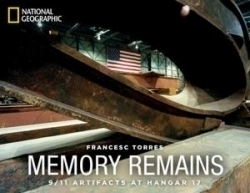
Memory Remains
9/11 Artifacts at Hangar 17
Before it became the repository for fifteen hundred artifacts from Ground Zero for nearly ten years, Hangar 17 was an empty airplane warehouse, a remote, 80,000-square-foot building at New York City’s Kennedy airport. Through Spanish artist Francesc Torres’ lens, however, the unevenly lit and nondescript space took on the aura of a monument. For within its shell, enormous sections of structural steel, “eloquent as the product[s] of the unbelievable destructive energy recorded in their twisted shapes,” were connected by an incredible silent narrative to other highly charged objects, among them a single American Airlines slipper.
In one of the book’s fine essays, “Seeing is Believing,” Jan Seidler Ramirez, chief curator and director of collections at the National September 11 Memorial & Museum, uses Torres’ images to inventory the hangar’s contents. She notes fire trucks, security patrol cars, and a yellow taxi aligned on either side of a long space and sees in the photograph “invalid veterans occupying beds in a hospital ward, swapping war stories.”
The most ghastly object, if such a thing can be quantified, is a so-called Composite, a chunk of molten debris measuring five by six by eight feet that clearly delineates four different stories from one of the towers, compressed to a thickness of four feet. As writer Jerry Adler, who covered the events of 9/11 for Newsweek, points out in the book’s essay “Recovering History,” “[A]lmost as interesting is what’s missing.” What of the desks and chairs occupied by the towers’ 35,000 tenants, he asks? Adler concludes that small, hard objects such as keys and rings that were caught (and protected) in crevices of larger pieces had the best chance of surviving what he likens to “a collision with an asteroid.” An impressive number of golf balls were recovered.
Like the deceased relative on view before his burial, who bears little resemblance to the formerly engaged person, Torres’ photographs detail objects no longer themselves. Altogether changed are the 80-foot-tall tridents that formed the base of the twin buildings and gave architect Minoru Yamasaki’s towers their gothic-inspired grace. Lying on their sides, their lengths cut down for transport, these clunky, pronged forms belong in an abandoned train yard. Torres communicates this sense of essential loss masterfully, admitting, “the emotional tension between that landscape of quiet, mutilated artifacts and the chaotic memory of the day of the attack was sometimes overpowering.”
Some contents from Hangar 17 have been dispersed to collections across the nation; but most artifacts will reinhabit their former site, this time displayed under the watchful eyes of conservators and curators at the National September 11 Memorial & Museum. A remarkable document, Memory Remains displays the remains of the day in the hope that memory persists.
Reviewed by
Julie Eakin
Disclosure: This article is not an endorsement, but a review. The publisher of this book provided free copies of the book to have their book reviewed by a professional reviewer. No fee was paid by the publisher for this review. Foreword Reviews only recommends books that we love. Foreword Magazine, Inc. is disclosing this in accordance with the Federal Trade Commission’s 16 CFR, Part 255.
